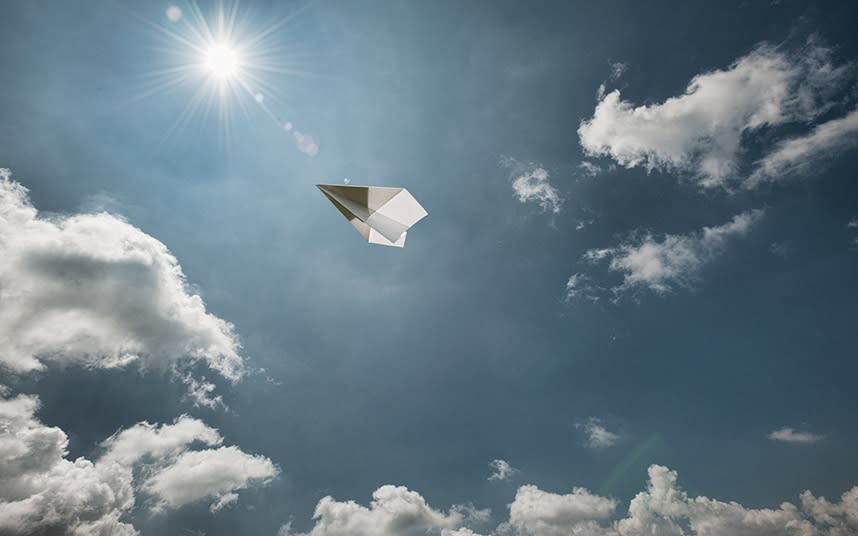Fat tax, empty bladders and the £30k olive: The bizarre lengths airlines go to lose weight

In 1987 American Airlines removed a single olive from each of its in-flight salads, reducing costs by a remarkable $40,000 (£30,000) a year.
The savings were two-fold - first, caterers at the carrier could cross off tens of thousands of olives from its weekly shopping list, but second, each aircraft would now be lighter. Olives are by no means hefty but when it comes to weight and subsequent fuel savings, airlines do not mess about.
With some planes burning up to a gallon of fuel every second, and fuel cost accounting for 21p of every pound spent by airlines (a figure set to rise in 2018), lightening the load is an easy way to tighten the belt.
Some attempts to reduce weight are more sensible than others. Virgin Atlantic, for example, made its glassware thinner and removed some of its heavy, slate plates from upper class. The carrier also changed its chocolate and sweet offerings to lighter versions, redesigned its meal trays (which in turn meant planes were able to carry fewer dining carts), and altered its beverage offering for night flights, when fewer people drink.
The airline has estimated that losing a pound in weight from every plane in its fleet would save 14,000 gallons of fuel a year, adding up to tens of thousands of pounds.
Anatomy of an airfare
British Airways, which has a dedicated fuel efficiency team, has also reduced the weight of its catering equipment, as well as printing its in-flight magazine on lighter paper. American carrier United did the same to its magazine, saving an ounce per copy and $300,000 (£227,000) a year.
The airline division of Thomas Cook, too, is constantly looking for ways to reduce the weight of its planes. In 2014 it invested in lightweight trolleys (one per cent fuel cost saving) and lighter seats.
The airline no longer prints receipts for in-flight purchases, saving it the need to carry 420,000 till rolls across its fleets, and reduced the weight of its in-flight magazine from 261g to 200g. It has also reduced the number of spare pillows and blankets it carries from four down to two. Light as a feather, maybe - but every gram counts.
Best of | Travel Truths
Less sensible ideas to reduce the weight of flights include Ryanair’s 2012 memo to staff to “watch their weight... with the motivation of appearing in the annual Ryanair calendar”, a celebration of the carrier’s annual charity publication that featured scantily-clad flight attendants but was scrapped in 2014.
The Irish airline did, however, also reduce the size of its magazine from A4 to A5 and cut the amount of ice taken on board. “We also considered removing armrests, but decided against it,” a spokesperson said in 2012.
In 2008, Air Canada removed life vests from some of its aircraft in favour of lighter floatation devices. Authorities approved the change, so long as it was limited to aircraft which didn’t venture more than 50 miles from the shore.
In the same year, Northwest Airlines, a US airline about to be absorbed by Delta, saved $500,000 a year, by slicing its limes - served in soft drinks - into 16 slices instead of 10, saving money in purchasing, but also carrying, less citrus.
This of course pales in comparison to the attempts of Japanese airline, All Nippon Airways, when in 2009 it asked passengers to visit the lavatory before boarding because empty bladders means lighter bladders.
Over the course of a month’s trial, the airline positioned staff near the boarding gates in terminals to ask passengers waiting for their flight to relieve themselves before boarding the aircraft. It hoped that the weight saved would lead to a five-tonne reduction in carbon emissions - and a small cost saving.
At a glance | How much fuel does a plane burn?
And then there was Samoa Air, which in 2013 introduced a “fat tax”, whereby passengers would be charged a fare according to their weight.
Chief executive Chris Langton told CNN at the time: “What makes airplanes work is weight. We are not selling seats, we are selling weight.”
This is, broadly speaking, why airlines charge for checked baggage, and imposes weight limits on all luggage, because the heavier the plane, the more it costs in fuel to fly.
15 surprising things you didn't know about long-haul flights
But airlines, despite Samoa Air’s revoutionary actions, have not yet reverted to a fully weight-relative charging system. If the industry did, passengers might be charged for bringing a mobile phone on board.
Researchers at MIT have estimated that each passenger carrying a phone on Southwest Airlines cost it $1.2million a year in weight-related fuel expenses, a figure that jumps to $21.6million if the phones were swapped for laptops.
Advances in aviation technology have somewhat mitigated the need for airlines to confiscate phones at the gate, or ask you to spenny a penny before stepping on board.
At a glance | Why are planes nearly always painted white?
New lighter, more fuel efficient aircraft produced by Boeing and Airbus, such as the 787 and the A350, where electrics replace heavy, mechanic systems, have led to large cuts in fuel bills, while upgrading the likes of the 737 and the A320, workhorses for many of the world’s low-cost and short-haul airlines, with new engines, has helped keep fares low. In developing its 777-300ER, the American plane manufacturer eliminated the need for 20,000 washers, saving 53kg.
Another industry-wide change that has helped each plane to an 18kg reduction in weight is swapping the wheelbarrow full of manuals and maps pilots require for a single iPad.
As long as the industry - and airlines - are innovating, heavy passengers are safe paying the average fare. But, as the examples above show, carriers are known to go to any length to cut costs, so don’t get too comfortable.

